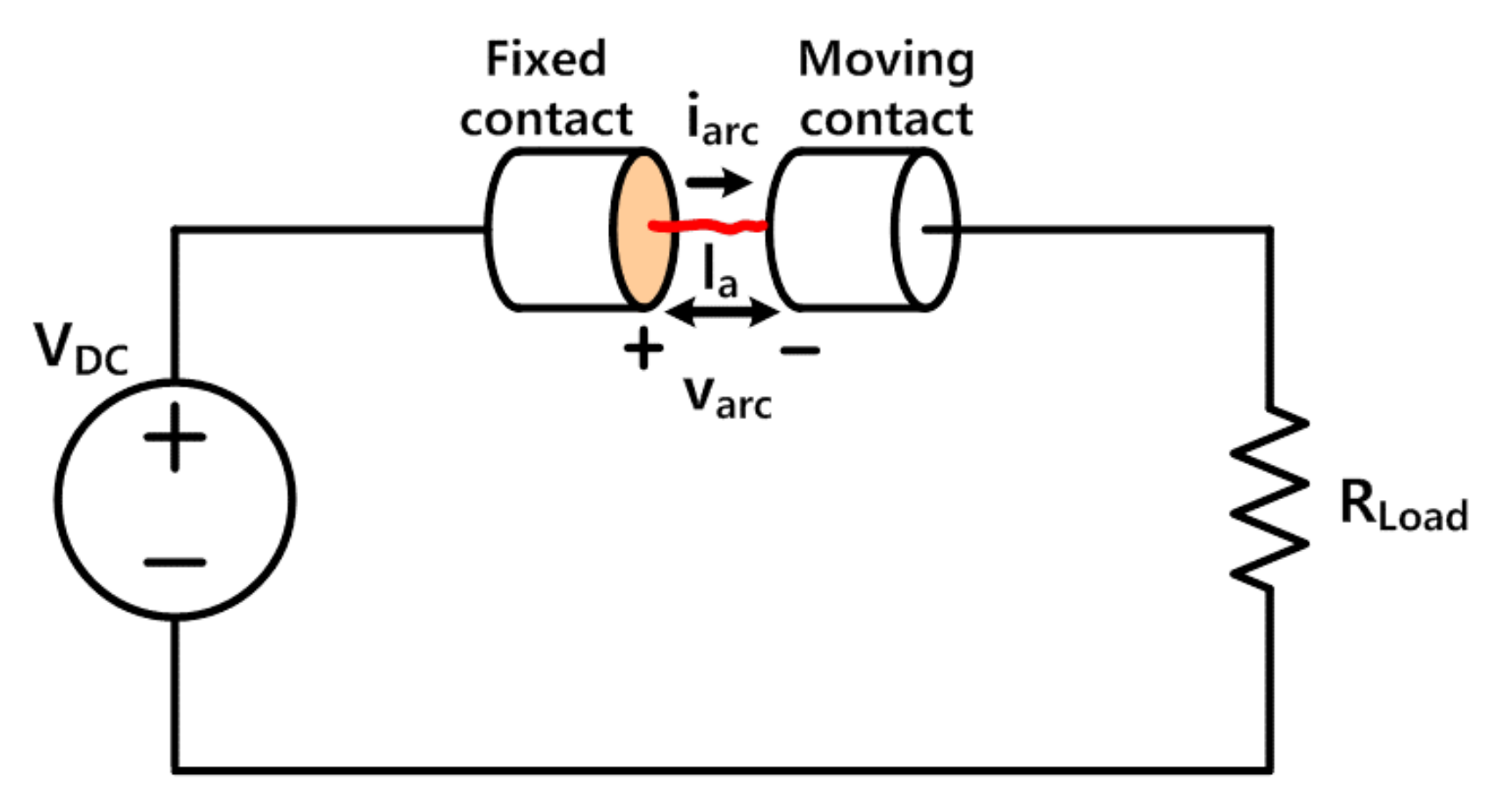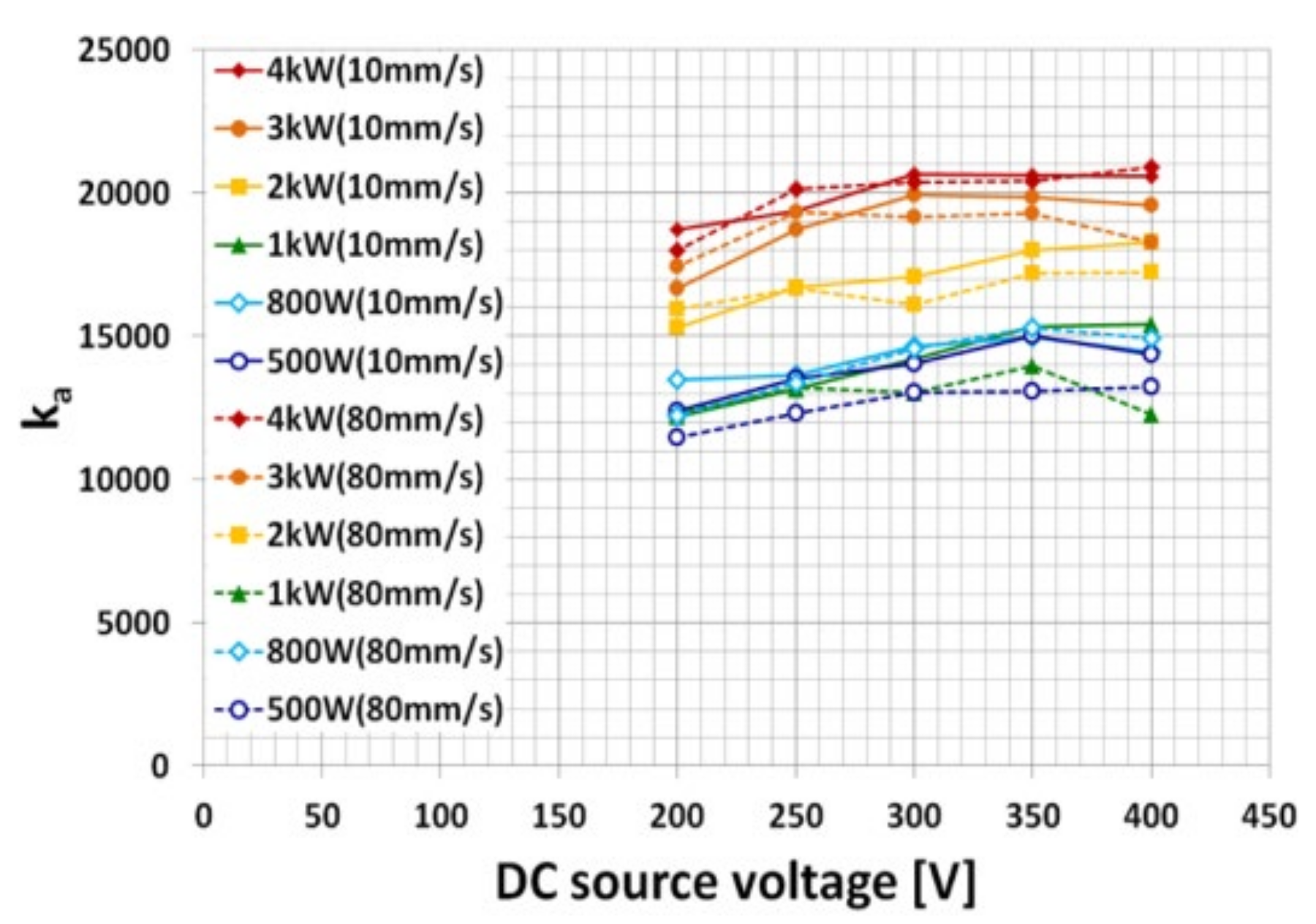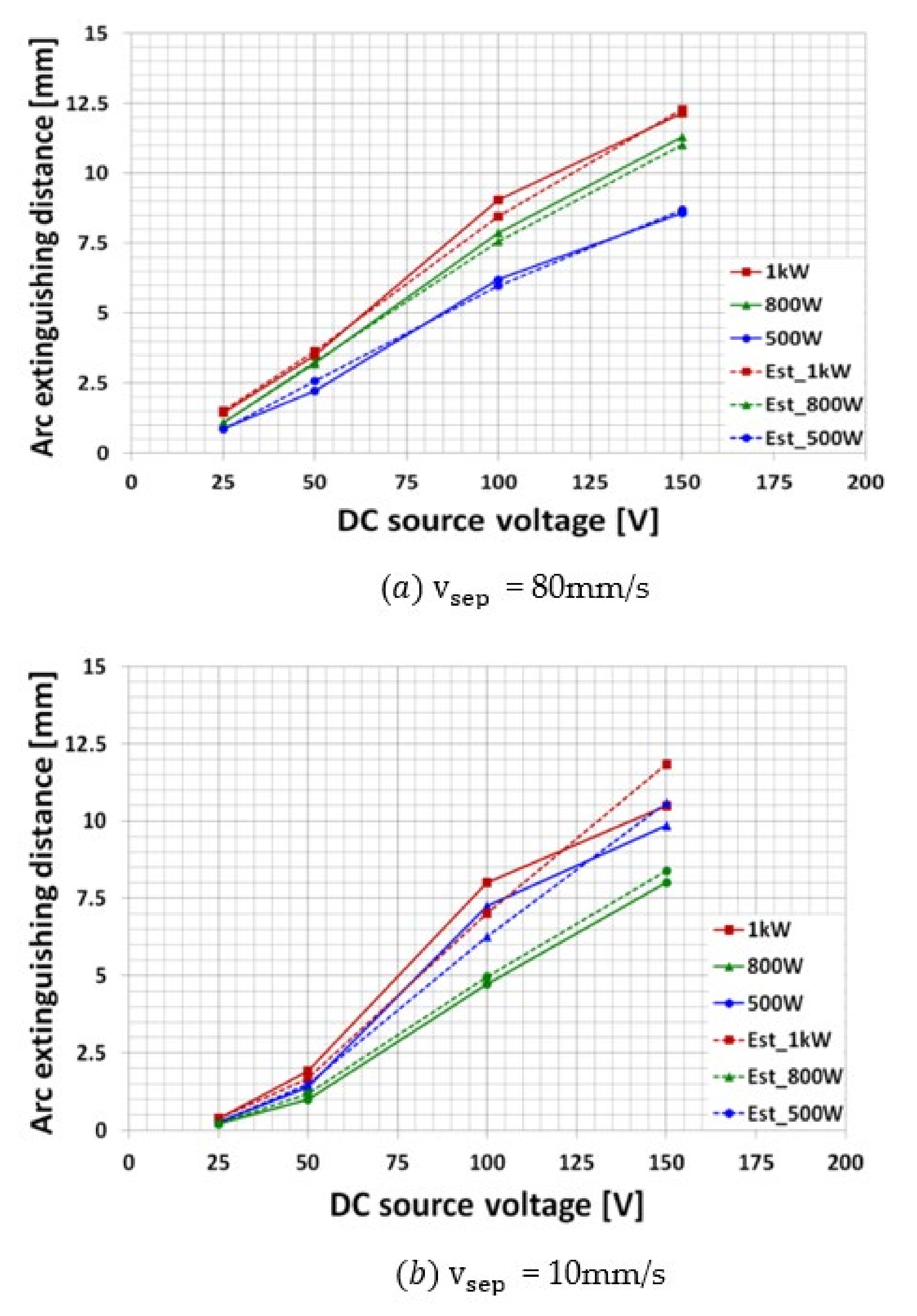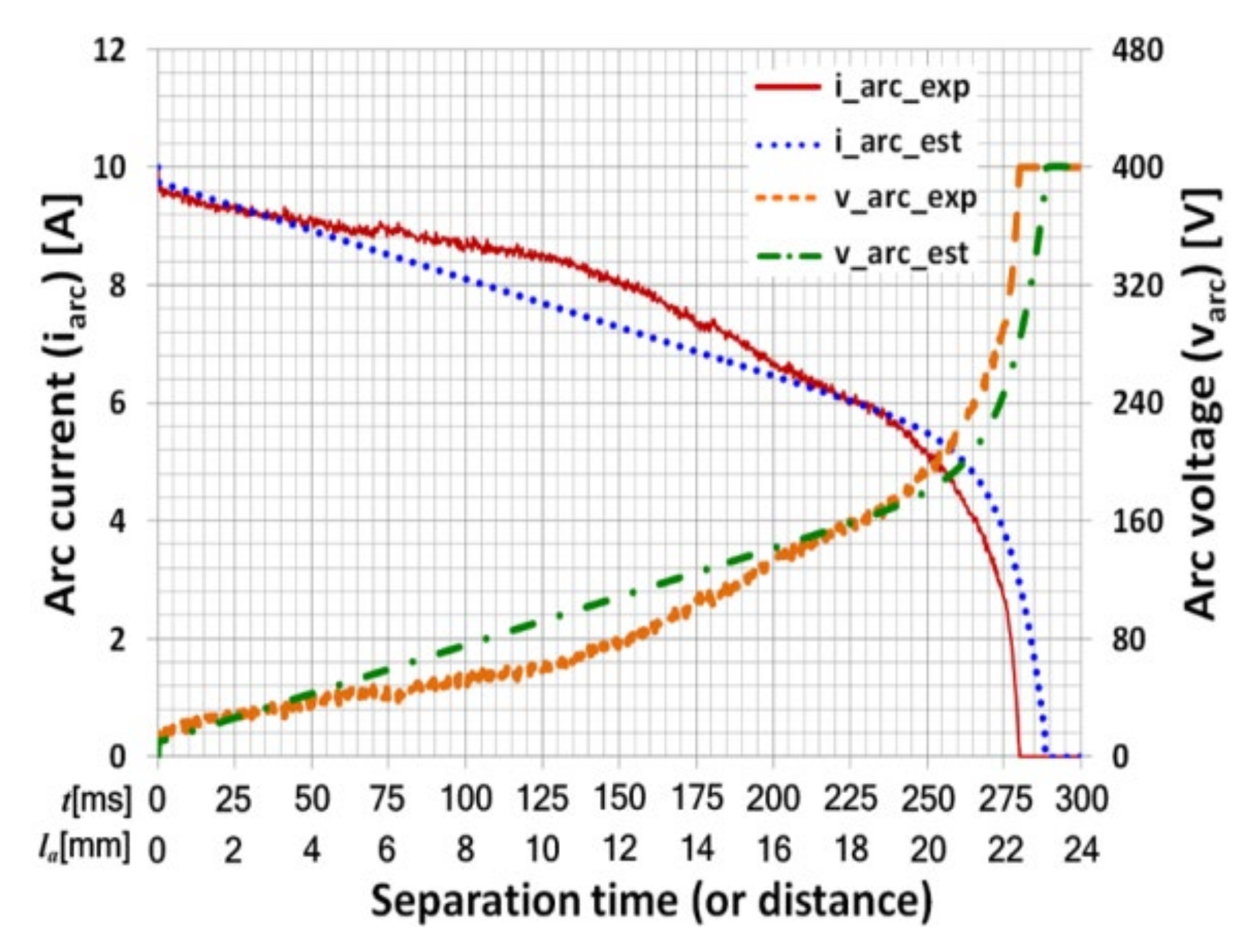Modeling and Estimation of Break Arc Extinction Distance in Low Voltage DC Systems
Abstract
:1. Introduction
2. DC Breaking Arc-Extinction Distance
2.1. Estimation of Arc Extinction Distance
2.2. Estimation of the Empirical Constant ka
3. Experiment
3.1. Experiment Condition
3.2. Experiment Results
3.2.1. Source Voltage < 200 V
3.2.2. Source Voltage > 200 V
3.3. Verification of Estimated Arc Constant ka_est
3.3.1. Source Voltage < 200 V
3.3.2. Source Voltage > 200 V
4. LVDC Series Arc Model
4.1. Arc Current Model
4.2. Arc Voltage Model
5. Conclusions
Author Contributions
Funding
Conflicts of Interest
References
- Xiao, D.; AlAshery, M.K.; Qiao, W. Optimal price-maker trading strategy of a wind power producer using virtual bidding. J. Mod. Power Syst. Clean Energy 2021, 1–13. [Google Scholar] [CrossRef]
- Xiao, D.; Qiao, W.; Qu, L. Risk-averse offer strategy of a photovoltaic solar power plant with virtual bidding in electricity markets. In Proceedings of the 10th IEEE Conference on Innovative Smart Grid Technology (ISGT 2019), Washington, DC, USA, 17–20 February 2019; pp. 1–5. [Google Scholar] [CrossRef]
- Liang, J.; Jing, T.; Gomis-Bellmunt, O.; Ekanayake, J.; Jenkins, N. Operation and control of multiterminal HVDC transmission for offshore wind farms. IEEE Trans. Power Deliv. 2011, 26, 2596–2604. [Google Scholar] [CrossRef]
- Raza, X.; Dianguo, S.; Xunwen, L.; Weixing, B.W.; Williams, A. Novel Multiterminal VSC-HVdc Transmission Topology for Offshore Wind Farms. IEEE Trans. Ind. Appl. 2017, 53, 1316–1325. [Google Scholar] [CrossRef]
- Rodriguez-Diaz, E.; Vasquez, J.C.; Guerrero, J.M. Intelligent DC homes in future sustainable energy systems: When efficiency and intelligence work together. IEEE Consum. Electron. Mag. 2016, 5, 74–80. [Google Scholar] [CrossRef] [Green Version]
- Dragicevic, T.; Vasquez, J.C.; Guerrero, J.M.; Skrlec, D. Advanced LVDC electrical power architectures and microgrids: A step toward a new generation of power distribution networks. IEEE Electrif. Mag. 2014, 2, 54–65. [Google Scholar] [CrossRef] [Green Version]
- Ghaffarpour, M.; Jahromi, G.; Mirzaeva, S.D.; Mitchell, D.G. Powering mobile mining machines: DC versus AC power. IEEE Ind. Appl. Mag. 2016, 22, 63–72. [Google Scholar] [CrossRef] [Green Version]
- Pecharroman, R.R.; Lopez-Lopez, A.; Cucala, A.P.; Fernandez-Cardador, A. Riding the rails to DC power efficiency: Energy efficiency in dc-electrified metropolitan railways. IEEE Electrif. Mag. 2014, 2, 32–38. [Google Scholar] [CrossRef]
- Bhatia, M.; Angelou, N. Beyond Connections: Energy Access Redefined; Energy Sector Management Assistance Program: Washington, DC, USA, 2015. [Google Scholar]
- Jhunjhunwala, P.K. Solar energy, dc distribution, and microgrids: Ensuring quality power in rural India. IEEE Electrif. Mag. 2018, 6, 32–39. [Google Scholar] [CrossRef]
- Shenai, K.; Jhunjhunwala, A.; Kaur, P. Electrifying India: Using solar dc microgrids. IEEE Power Electron. Mag. 2016, 3, 42–48. [Google Scholar] [CrossRef]
- Jhunjhunwala, A.; Lolla, A.; Kaur, P. Solar-DC microgrid for Indian homes: A transforming power scenario. IEEE Electrif. Mag. 2016, 4, 10–19. [Google Scholar] [CrossRef]
- LVDC: Electricity for the 21st Century; IEC Technical Report; IEC: London, UK, 2015.
- Kumar, D.; Zare, F.; Ghosh, A. DC microgrid technology: System architectures AC grid interfaces grounding schemes power quality communication networks applications and standardizations aspects. IEEE Access 2017, 5, 12230–12256. [Google Scholar] [CrossRef]
- Hesla, E. DC task team report. IEEE Trans. Ind. Appl. 2014, 50, 2996–3003. [Google Scholar] [CrossRef]
- Gordon, L.B.; Cartelli, L.; Graham, N. A complete electrical shock hazard classification system and its application. IEEE Trans. Ind. Appl. 2018, 54, 6554–6565. [Google Scholar] [CrossRef]
- IEC 60479-1. Effects of Current on Human Beings and Livestock–Part 1: General Aspects; IEC: London, UK, 2015. [Google Scholar]
- NFPA 70E. Updates, Affect Your Most Valuable Assets; NFPA: Quincy, MA, USA, 2015. [Google Scholar]
- Koziy, K.; Gou, B.; Aslakson, J. A low-cost power-quality meter with series arc-fault detection capability for smart grid. IEEE Trans. Power Deliv. 2013, 28, 1584–1591. [Google Scholar] [CrossRef]
- Naidu, M.; Schoepf, T.J.; Gopalakrishnan, S. Arc fault detection scheme for 42-V automotive DC networks using current shunt. IEEE Trans. Power Electron. 2006, 21, 633–639. [Google Scholar] [CrossRef]
- Gammon, T.; Lee, W.; Zhang, Z.; Johnson, B.C. A Review of Commonly Used DC Arc Models. IEEE Trans. Ind. Appl. 2015, 51, 1398. [Google Scholar] [CrossRef]
- Khakpour, A.; Franke, S.; Uhrlandt, D.; Gorchakov, S.; Methling, R. Electrical Arc Model Based on Physical Parameters and Power Calculation. IEEE Trans. Plasma Sci. 2015, 43, 2721. [Google Scholar] [CrossRef]
- Rau, S.-H.; Lee, W.-J. DC Arc Model Based on 3-D DC Arc Simulation. IEEE Trans. Ind. Appl. 2016, 52, 5255–5261. [Google Scholar] [CrossRef]
- Siewert, E.; Baeva, M.; Uhrlandt, D. The electric field and voltage of dc tungsten-inert gas arcs and their role in the bidirectional plasma-electrode interaction. J. Phys. D Appl. Phys. 2019, 52, 324006. [Google Scholar] [CrossRef]
- Misato, S.; Yoshiaki, E.; Masayoshi, S. Relationship between Arc Behavior and Parameters of the Arc Root Model in the Arc Gas Flow Analysis. In Proceedings of the 5th IEEE International Conference on Electric Power Equipment-Switching Technology (ICEPE-ST), Kitakyushu, Japan, 13–16 October 2019. [Google Scholar] [CrossRef]
- Xiaowen, X.; Shiyou, Y.; Qiang, Z.; Yanhong, M. A 2-D Axisymmetric Magneto-Hydrodynamic Model of a DC Arc Plasma Torch and Its Solution Methodology. IEEE Trans. Magn. 2020, 56, 1–4. [Google Scholar] [CrossRef]
- Mayr, O. Beitrage zur Theorie des Statischen und des Dynamischen Lichtbogens. Arch. Elektr. 1943, 37, 588–608. [Google Scholar] [CrossRef]
- Cassie, A.M. Arc Rupture and Circuit Severity: A New Theory. In Proceedings of the Conférence Internationale des Grands Réseaux Électriques à Haute Tension (CIGRE Report), Paris, France, 29 June–8 July 1939; Volume 102, pp. 1–14. [Google Scholar]
- Schavemaker, P.H.; Slui, L. An improved Mayr-type arc model based on current-zero measurements [circuit breakers]. IEEE Trans. Power Deliv. 2000, 15, 580–584. [Google Scholar] [CrossRef]
- Guardado, J.L.; Maximov, S.G.; Melgoza, E.; Naredo, J.L.; Moreno, P. An improved arc model before current zero based on the combined Mayr and Cassie arc models. IEEE Trans. Power Deliv. 2005, 20, 138. [Google Scholar] [CrossRef]
- Gao, Y.; Wang, L.; Zhang, Y.; Zeng, K. Research on the Calculation Method for the Parameters of the Simplified Schavemaker AC Arc Model. In Proceedings of the 2018 Prognostics and System Health Management Conference (PHM-Chongqing), Chongqing, China, 26–28 October 2018; pp. 150–156. [Google Scholar] [CrossRef]
- Xiaorui, Z.; Liang, W.; Sheng, L.; Zhentao, D.; Yabin, Y. Research on modeling and characteristic analysis of arc in DC Circuit Breaker. In Proceedings of the IEEE 8th International Conference on Advanced Power System Automation and Protection (APAP), Xi’an, China, 21–24 October 2019. [Google Scholar] [CrossRef]
- He, J.; Wang, K.; Jiangang, L. Application of an Improved Mayr-Type Arc Model in Pyro-Breakers Utilized in Superconducting Fusion Facilities. Energies 2021, 14, 4383. [Google Scholar] [CrossRef]
- Khakpour, A.; Franke, S.; Gortschakow, S.; Uhrlandt, D.; Methling, R.; Weltmann, K.-D. An Improved Arc Model Based on the Arc Diameter. IEEE Trans. Power Deliv. 2016, 31, 1335–1341. [Google Scholar] [CrossRef]
- Steinmetz, C.P. Electric power into light, Section VI. The arc. Trans. Am. Inst. Electr. Eng. 1906, 25, 802. [Google Scholar]
- Nottingham, W.B. A new equation for the static characteristic of the normal electric arc. Trans. Am. Inst. Electr. Eng. 1923, 42, 12–19. [Google Scholar] [CrossRef]
- Stokes, A.D.; Oppenlander, W.T. Electric arcs in open air. J. Phys. D Appl. Phys. 1991, 24, 26–35. [Google Scholar] [CrossRef]
- Ammerman, R.F.; Gammon, T.; Sen, P.K.; Nelson, J.P. DC-arc models and incident-energy calculations. IEEE Trans. Ind. Appl. 2010, 46, 1810–1819. [Google Scholar] [CrossRef]
- Fisher, L.E. Resistance of low-voltage ac arcs. IEEE Trans. Ind. Gen. Appl. 1970, 6, 607–616. [Google Scholar] [CrossRef]
- Kyu-Hoon, P.; Ho-Yun, L.; Bang-Wook, L. The Analysis of Low-Voltage DC Arc behavior on Three Interrupting Phases Based on AC Black-box Arc model. In Proceedings of the IEEE 2019 5th International Conference on Electric Power Equipment-Switching Technology (ICEPE-ST), Kitakyushu, Japan, 13–16 October 2019. [Google Scholar] [CrossRef]
- Ruiyang, G.; Zhidong, J.; Songhai, F.; Xinghai, Z.; Tao, W.; Yuanshi, D. DC Arc Self-Extinction and Dynamic Arc Model in Open-Space Condition Using a Yacob Ladder. IEEE Trans. Plasma Sci. 2019, 47, 4721–4728. [Google Scholar] [CrossRef]
- Paukert, J. The arc voltage and the resistance of LV fault arcs. In Proceedings of the 7th International Symposium on Switching Arc Phenomena, Łódź, Poland, 27 September–11 October 1993; pp. 49–51. [Google Scholar]
- Andrea, J.; Schweitzer, P.; Carvou, E. Comparison of equations of the VI characteristics of an electric arc in open air. In Proceedings of the IEEE Holm Conference on Electrical Contacts, Milwaukee, WI, USA, 15–18 September 2019; pp. 76–81. [Google Scholar] [CrossRef]
- Zhang, Z.; Nie, Y.; Lee, W.-J. Approach of Voltage Characteristics Modeling for Medium-Low-Voltage Arc Fault in Short Gaps. IEEE Trans. Ind. Appl. 2019, 55, 2281–2289. [Google Scholar] [CrossRef]
- Ammar, N.; Petrus, P.; Dirk, U. Electrical Modelling of Switching Arcs in a Low Voltage Relay at Low Currents. Energies 2020, 13, 6377. [Google Scholar] [CrossRef]
- Uriarte, F.M.; Gattozzi, A.; Herbst, J.; Estes, H.; Hotz, T.; Kwasinski, A.; Hebner, R. A DC Arc Model for Series Faults in Low Voltage Microgrids. IEEE Trans. Smart Grid 2012, 3, 2063–2070. [Google Scholar] [CrossRef] [Green Version]
- Kim, W.; Kim, Y.-J.; Kim, H. Arc Voltage and Current Characteristics in Low-Voltage Direct Current. Energies 2018, 11, 2511. [Google Scholar] [CrossRef] [Green Version]
- Kim, Y.-J. Modeling for Series Arc of DC Circuit Breaker. IEEE Trans. Ind. Appl. 2019, 55, 6. [Google Scholar] [CrossRef]











| Source voltage [V] | 12, 25, 50, 100, 150, 200, 250, 300, 350, 400 |
| Load Power [W] | 500, 800, 1k, 2k, 3k, 4k |
| Separation speed [mm/s] | 10, 80 |
| Maximum Separation distance [mm] | 30 |
| Gas medium | Air |
| Temperature [C] | 24~26 |
| Humidity [%] | 60~70 |
Publisher’s Note: MDPI stays neutral with regard to jurisdictional claims in published maps and institutional affiliations. |
© 2021 by the authors. Licensee MDPI, Basel, Switzerland. This article is an open access article distributed under the terms and conditions of the Creative Commons Attribution (CC BY) license (https://creativecommons.org/licenses/by/4.0/).
Share and Cite
Kim, Y.-J.; Kim, H.-S. Modeling and Estimation of Break Arc Extinction Distance in Low Voltage DC Systems. Energies 2021, 14, 6646. https://doi.org/10.3390/en14206646
Kim Y-J, Kim H-S. Modeling and Estimation of Break Arc Extinction Distance in Low Voltage DC Systems. Energies. 2021; 14(20):6646. https://doi.org/10.3390/en14206646
Chicago/Turabian StyleKim, Yong-Jung, and Hyo-Sung Kim. 2021. "Modeling and Estimation of Break Arc Extinction Distance in Low Voltage DC Systems" Energies 14, no. 20: 6646. https://doi.org/10.3390/en14206646







